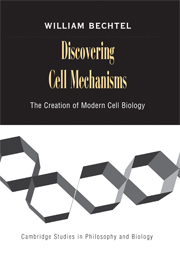Book contents
- Frontmatter
- Contents
- Preface
- 1 Introduction: Cell Mechanisms and Cell Biology
- 2 Explaining Cellular Phenomena through Mechanisms
- 3 The Locus of Cell Mechanisms: Terra Incognita between Cytology and Biochemistry
- 4 Creating New Instruments and Research Techniques for Discovering Cell Mechanisms
- 5 Entering the Terra Incognita between Biochemistry and Cytology: Putting New Research Tools to Work in the 1940s
- 6 New Knowledge: The Mechanisms of the Cytoplasm
- 7 Giving Cell Biology an Institutional Identity
- Afterword
- References
- Index
5 - Entering the Terra Incognita between Biochemistry and Cytology: Putting New Research Tools to Work in the 1940s
Published online by Cambridge University Press: 05 June 2012
- Frontmatter
- Contents
- Preface
- 1 Introduction: Cell Mechanisms and Cell Biology
- 2 Explaining Cellular Phenomena through Mechanisms
- 3 The Locus of Cell Mechanisms: Terra Incognita between Cytology and Biochemistry
- 4 Creating New Instruments and Research Techniques for Discovering Cell Mechanisms
- 5 Entering the Terra Incognita between Biochemistry and Cytology: Putting New Research Tools to Work in the 1940s
- 6 New Knowledge: The Mechanisms of the Cytoplasm
- 7 Giving Cell Biology an Institutional Identity
- Afterword
- References
- Index
Summary
In recent years, the construction of a bridge between these two levels of knowledge has been initiated. This has been due to the adaptation and employment in biology of techniques derived from physics and chemistry and to the breaking down of the barriers which previously separated these sciences. Below the structure visible to the microscope there exists a true organization of molecules and micelles in the different phases of the system which constitute protoplasm.
(de Robertis et al., 1949, p. 64).New research tools, especially cell fractionation and electron microscopy, opened for investigation the uncharted territory between biochemistry and cytology. The goal was to explain how cells carry out their basic functions. In the nineteenth and early twentieth century, the activity that had received the most attention was cell reproduction. The basic operations in cell division, including those carried out by chromosomes in the nucleus, had been described by cytologists using stains and the apochromatic lens decades before the advent of cell biology. The focus of early cell biology was rather on functions performed in the cytoplasm, especially capturing energy and synthesizing proteins. The first important steps in developing mechanistic explanations of these functions was to identify the mitochondrion and the endoplasmic reticulum as the cell organelles responsible for each, a project largely accomplished in the 1940s (although the name endoplasmic reticulum was not introduced until the early 1950s).
- Type
- Chapter
- Information
- Discovering Cell MechanismsThe Creation of Modern Cell Biology, pp. 162 - 189Publisher: Cambridge University PressPrint publication year: 2005



